Manta Ray Night Snorkel: A Hawaiian Adventure
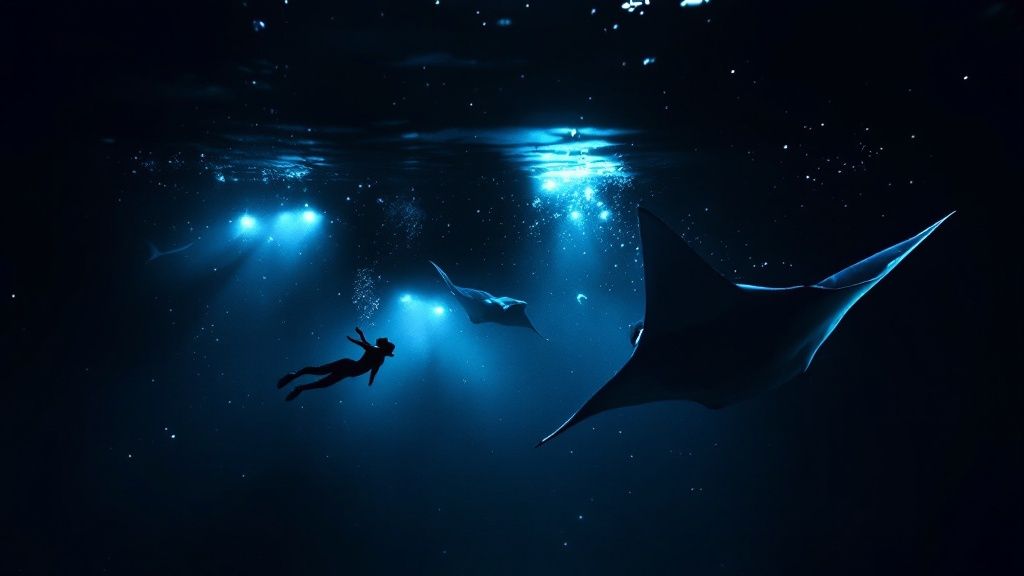
The Magic of Manta Ray Night Snorkeling Revealed
Imagine floating in the warm, dark waters off the Kona Coast. The only light comes from specialized boards below you. Suddenly, a giant manta ray appears. Its wingspan can reach an incredible 20 feet. This is the magic of manta ray night snorkeling.
This unique experience offers a close encounter with these gentle giants during their feeding rituals. It's a truly unforgettable experience.
Manta ray night snorkeling provides a unique perspective on these graceful creatures. The specialized lighting attracts plankton, their main food source. This creates a mesmerizing spectacle. You'll be able to observe the mantas up close, all while respecting their natural behaviors. For more ocean activities, you can explore our sitemap.
Understanding the Manta Ray Feeding Frenzy
The lights used during night snorkeling mimic the moon's reflection. This attracts microscopic plankton. These tiny organisms, in turn, draw in the hungry manta rays.
The mantas feast with acrobatic grace. They perform barrel rolls and backflips, their white underbellies flashing against the dark water. It's a truly breathtaking sight to behold. It's amazing to consider that some manta rays, despite their immense size, feed exclusively on these tiny plankton. If you're interested in a guided manta ray experience, consider a Manta Ray Night Snorkel Big Island adventure.
This predictable feeding behavior allows snorkelers to witness this natural wonder. Manta ray night snorkeling boasts a high success rate for spotting these creatures. Operators like Jack's Diving Locker report an 85-90% success rate.
This high frequency of encounters is due to the strategic use of light attracting plankton, which, in turn, draws in the manta rays. Ideal locations like Makako Bay (Garden Eel Cove) and Keauhou Bay provide warm, clear waters with excellent visibility.
The popularity of these trips has grown, with over 80,000 people participating annually. These eco-friendly marine experiences have become highly sought after. More detailed statistics can be found here. Manta ray night snorkeling is an incredibly rewarding experience.
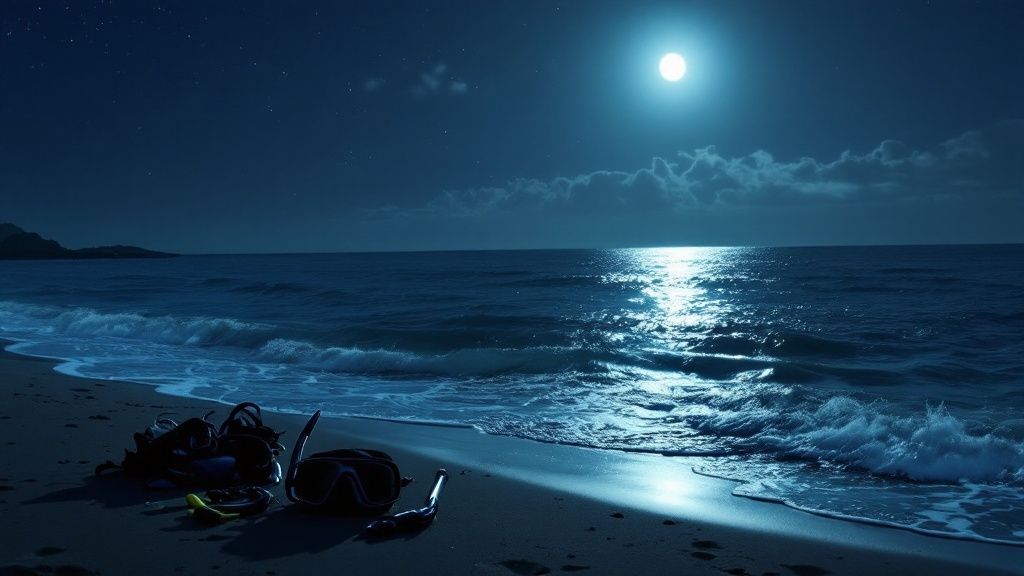
Hawaii's Premier Manta Ray Encounters: Location Secrets
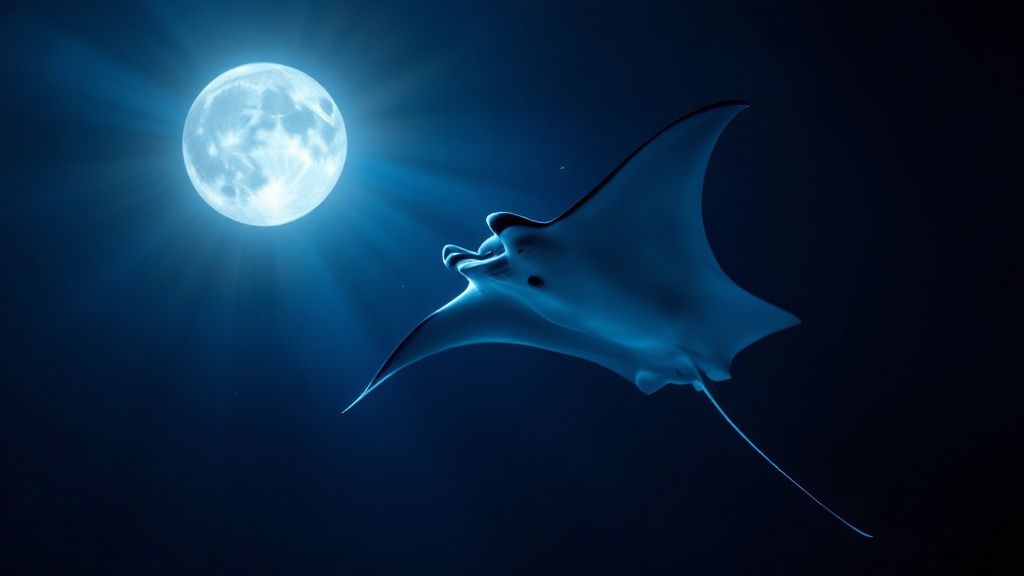
When it comes to snorkeling with manta rays, not all locations are equal. The Kona Coast of Hawaii is renowned for its consistent manta ray sightings, with two spots standing out: Makako Bay (Manta Heaven) and Keauhou Bay (Manta Village). Each offers unique characteristics that enhance the manta ray night snorkel experience.
Makako Bay: Manta Heaven
Makako Bay boasts a shallow, sandy bottom, providing exceptional water clarity. This allows for unparalleled views of the mantas’ graceful movements as they feed on plankton. The bay’s easy accessibility makes it a favorite among tour operators. The generally calm waters also create a more comfortable snorkeling environment.
Keauhou Bay: Manta Village
Keauhou Bay provides a slightly different, yet equally captivating experience. Its deeper waters and unique underwater landscape generate currents that concentrate plankton. This abundance of food attracts large numbers of manta rays. The lights from tour boats illuminate the plankton, drawing the mantas closer to the surface, creating a spectacular show for snorkelers.
Historically, considerable effort has gone into tracking manta ray sightings, contributing to a deeper understanding of these creatures. From 2009 to 2014, underwater videographers documented individual manta rays and their behaviors at both Manta Village and Manta Heaven. This research provided valuable data on their movement patterns and feeding habits. For more detailed statistics on manta rays, visit Manta Ray Advocates.
To help you choose the best spot for your manta ray adventure, we've put together a comparison table:
To help you choose the best spot for your next manta ray adventure, we've put together a handy comparison of the top locations:
Comparison of Top Manta Ray Night Snorkel Locations in Hawaii
A detailed comparison of the main manta ray viewing sites in Hawaii, showing their unique characteristics and what visitors can expect at each location
| Location | Average Manta Sightings | Best Time of Year | Water Conditions | Notable Features |
|---|---|---|---|---|
| Makako Bay (Manta Heaven) | High | Year-round | Typically calm, excellent visibility | Shallow, sandy bottom, easy access |
| Keauhou Bay (Manta Village) | High | Year-round | Can have some current, good visibility | Deeper water, unique topography, plankton-rich |
As you can see, both locations offer incredible opportunities to witness these magnificent creatures. Makako Bay excels in its calm conditions and visibility, while Keauhou Bay provides a dynamic environment with potentially higher concentrations of manta rays.
Exploring Other Locations
While Manta Heaven and Manta Village are the most popular locations, other less-known spots offer a more intimate manta ray night snorkel experience. Often farther from tourist hubs, these hidden gems can provide unique encounters with mantas in smaller groups. This translates to a more personalized and memorable experience. For more information and options, check out Our sitemap.
Seasonal Variations and Manta Behavior
Seasonal changes influence both water visibility and manta ray behavior. Summer months (April-October) generally have calmer, clearer water, ideal for optimal viewing. However, this also coincides with peak tourist season. Winter months (November-March) can have choppier water and slightly reduced visibility. Regardless of the season, manta rays are present year-round, offering an unforgettable experience anytime. Several tour operators offer guided excursions, including Kona Honu Divers, Manta Ray Night Snorkel Hawaii, Kona Snorkel Trips, and Captain Cook Snorkeling Tours.
Your Manta Ray Night Snorkel Journey: What to Expect
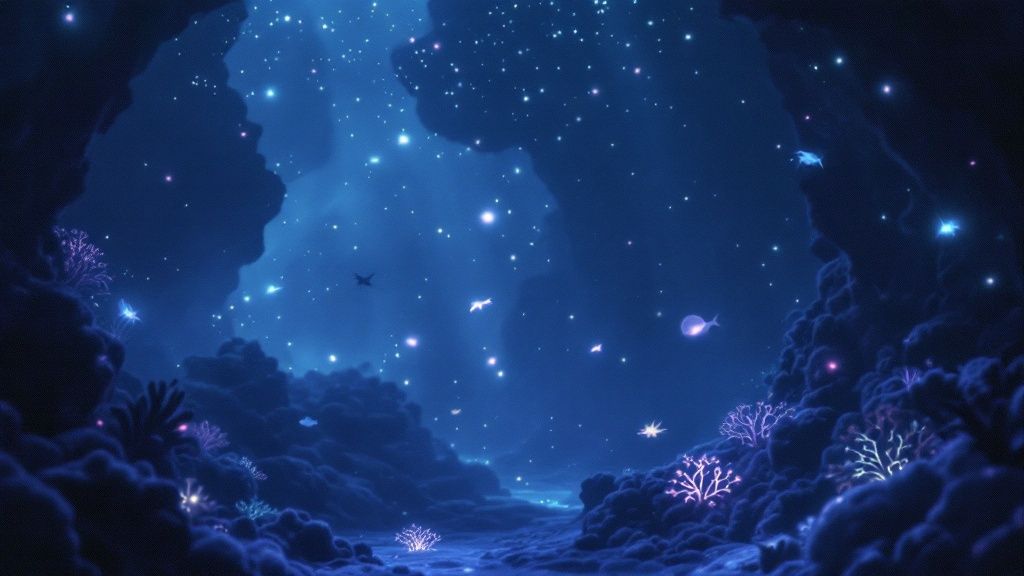
A manta ray night snorkel is an unforgettable adventure, and the excitement begins well before you even dip your toes in the water. From check-in to post-snorkel relaxation, every moment contributes to the overall experience. Here's a glimpse of what you can expect on a typical manta ray night snorkel. You might be interested in further exploring related activities.
Preparing for Departure
Most tours start with a check-in, allowing you to meet your guides and the other snorkelers joining you. A comprehensive safety briefing follows, covering all the essential procedures and addressing any questions. Then, it’s time for equipment fitting. Guides ensure everyone has a correctly sized wetsuit, mask, and snorkel. Some operators, like Kona Honu Divers, provide flotation devices for extra comfort and security.
Journey to the Snorkel Site
Once everyone's ready, a short boat trip takes you to the snorkel site. As the sun sets over the Kona coastline, enjoy beautiful ocean views. During the ride, guides often share intriguing facts about manta rays and the local marine environment, increasing the anticipation for the incredible encounter to come. Operators like Captain Cook Snorkeling Tours carefully choose the best viewing locations based on current ocean conditions and known manta ray activity.
Entering the Water and the Manta Ray Ballet
At locations like Manta Village or Manta Heaven, the guides explain the lighting system. These specialized lights, similar to those used by Manta Ray Night Snorkel Hawaii, attract plankton, the manta rays' primary food source. You'll then enter the water, usually holding onto a floating platform or board equipped with lights. This creates a stable and comfortable viewing experience, minimizing disruption to the manta rays. As the plankton congregate, the magnificent manta rays arrive. They glide through the illuminated water, performing what many describe as an underwater ballet. Their graceful movements include gentle passes, dramatic barrel rolls, and impressive somersaults as they feed. These close encounters, often just inches away, are the core of this unique experience. Kona Snorkel Trips emphasizes both exceptional customer service and responsible viewing practices.
Post-Snorkel Reflections
After about 20-30 minutes in the water, you'll return to the boat. The journey back provides a perfect opportunity to share the experience and discuss the amazing manta ray behaviors witnessed. Many tours offer warm drinks and snacks as you relive the magic of your manta ray night snorkel. This concluding part of the tour allows for reflection on this special encounter.
Selecting Your Perfect Manta Ray Night Snorkel Adventure
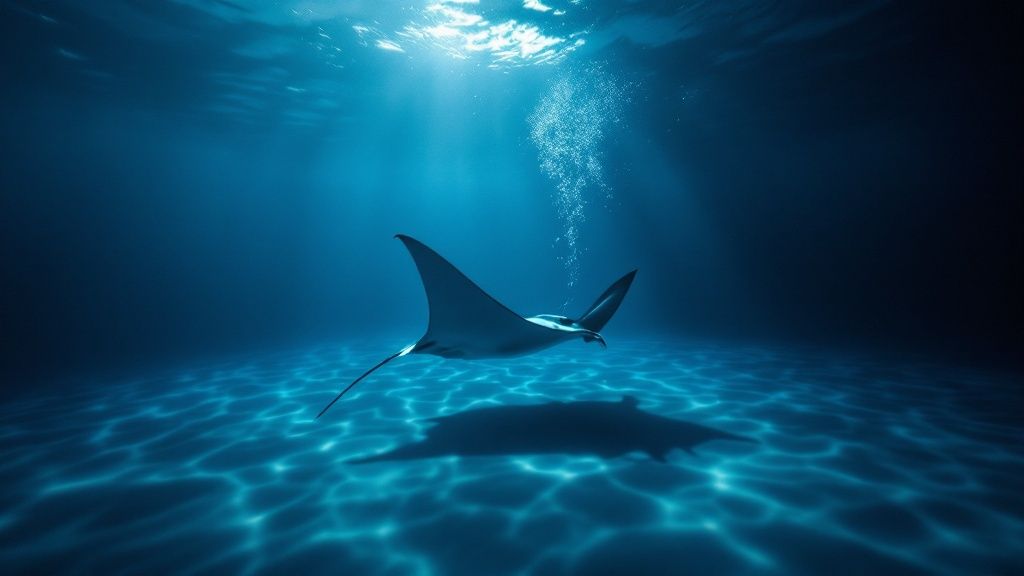
Planning a manta ray night snorkel? Not all tours are the same. Choosing the right operator can make a big difference in your experience. It's about more than just cost. This guide helps you pick the perfect tour for your needs.
Key Factors To Consider
A few things set apart a great manta ray snorkel trip from an average one. Boat design, for example, affects comfort and access. Larger boats are stable, but smaller ones can reach less crowded spots.
Guide expertise is also key. Good guides can point out individual manta rays, explain their behavior, and add to the experience.
Finally, think about group size. Smaller groups mean more personal attention and less disruption to the manta rays.
Comparing Top Tour Operators
To make choosing easier, we’ve compared some top manta ray night snorkel tour providers. This table summarizes their offerings, giving you a head start on planning your adventure.
Top Manta Ray Night Snorkel Tour Operators Comparison: A comprehensive comparison of leading tour operators offering manta ray night snorkel experiences, including their features, pricing, and unique selling points.
| Tour Operator | Group Size | Duration | Inclusions | Price Range | Special Features |
|---|---|---|---|---|---|
| Kona Honu Divers | Small | ~2 hours | Wetsuits, gear, snacks | $$ | Focus on personalized experiences |
| Manta Ray Night Snorkel Hawaii | Medium | ~2 hours | Gear, flotation devices | $$ | Emphasis on safety and comfort |
| Kona Snorkel Trips | Small-Medium | ~2 hours | Gear, hot drinks | $$ | Exceptional customer service and responsible viewing |
| Captain Cook Snorkeling Tours | Varies | ~2-3 hours | Varies depending on tour | $-$$ | Wide range of tour options |
Remember to check the operators' websites for the latest details.
Evaluating Value and Safety
Price is important, but true value means more. Look at the operator's commitment to marine conservation and their safety record. Responsible operators minimize disturbance to the manta rays.
Ask about their safety measures, too, like staff training and emergency plans. These things matter for a safe and ethical trip.
Prepare Like a Pro for Your Manta Ray Encounter
Getting ready for a manta ray night snorkel involves more than just reserving your spot. Proper preparation significantly impacts your enjoyment and comfort, allowing you to fully absorb this amazing experience. This includes planning what to bring, thinking about your pre-snorkel meal, and understanding how wetsuit choices affect your time in the water. For more information, you can check out our sitemap.
Gearing Up for Success: Packing Essentials
Pack smart for your manta ray adventure. A dry bag is crucial for protecting your valuables. Bring a light towel for after your snorkel, and dress in layers as Hawaiian evenings can be surprisingly cool. Don't forget reef-safe sunscreen to apply before you board the boat.
Pre-Snorkel Meal Planning: Combating Seasickness
A bit of planning can prevent seasickness. Eat a light meal a few hours before the tour. Avoid heavy or greasy foods that might upset your stomach. Consider ginger supplements or motion sickness medication if you are susceptible.
Wetsuit Wisdom: Choosing the Right Thickness
The right wetsuit thickness is essential for comfort and buoyancy. Most tour operators provide wetsuits, but understanding your options is helpful. A thinner 3mm wetsuit offers more flexibility, which is good for experienced snorkelers. A thicker 5mm wetsuit provides more warmth and buoyancy, a good choice for newer snorkelers or those who chill easily.
Addressing Night Snorkeling Anxieties
Night snorkeling can be intimidating for some, but there are ways to feel more comfortable. Talk to your guide about any concerns. They're experienced in helping people relax in the water. Remember, you'll be with a group and tethered to a lighted float, providing a sense of security and a point of reference. Focusing on the amazing creatures below and taking deep breaths can ease anxiety.
Special Considerations: Children, Seniors, and Mobility
Manta ray night snorkels are generally suitable for all ages and abilities, with a few things to keep in mind. If you're bringing children, make sure they are comfortable in the water and understand safety instructions. For seniors or those with mobility issues, discuss any special needs with the tour operator beforehand. They can often accommodate requests for a more comfortable trip.
Underwater Photography: Capturing the Magic Responsibly
Taking photos and videos requires specialized equipment. GoPros are popular choices due to their small size and durability. Secure your camera to your wrist or a float to prevent it from getting lost. Red filters compensate for blue light absorbed by the water at night, dramatically improving the color of your underwater photos. Remember to focus on the experience rather than getting the perfect shot. Avoid flash photography, as it can disturb the mantas and other marine life.
Mental Preparation: Embracing the Wonder
Finally, prepare yourself for an unforgettable experience. Manta rays are gentle giants, and seeing them at night is genuinely inspiring. Embrace the wonder of the moment, and let yourself be captivated by their graceful movements. This will surely be a treasured memory.
Beyond Observation: Conservation and Manta Ray Protection
Your manta ray night snorkel is more than an unforgettable experience; it's a direct contribution to important manta ray conservation work. Responsible tourism plays a key role in protecting these graceful creatures in Hawaiian waters. This mutually beneficial relationship helps both the mantas and the local communities. For more information about our offerings, check out our sitemap.
The Impact of Responsible Tourism
Data collected during commercial manta ray night snorkel tours has greatly expanded our understanding of manta ray populations. This research covers their complex behaviors, migratory routes, and general well-being. Such data is essential for both researchers and conservationists.
For example, ongoing observation has enabled scientists to identify individual manta rays. They can then track their movements and study their feeding patterns, which offers a deeper insight into how these animals interact with their surroundings. Ethical tour operators like Kona Honu Divers collaborate with researchers, providing valuable data.
Guidelines for Non-Disruptive Encounters
Responsible operators adhere to strict protocols to minimize their effect on the manta rays. These include appropriate lighting methods that attract plankton without confusing the mantas. Respectful positioning in the water is also essential.
Snorkelers should avoid obstructing the manta rays’ paths or overcrowding them. Operators like Manta Ray Night Snorkel Hawaii promote zero-contact policies. They stress the significance of observing these magnificent animals without any physical interaction. This approach protects the mantas’ delicate skin and reduces the possibility of spreading diseases.
Conservation Success Stories: Tourism’s Positive Impact
The financial contributions from tourism have been vital in supporting critical research and conservation projects. The revenue generated from manta ray tours often directly funds habitat protection and future studies. Kona Snorkel Trips, for example, is dedicated to sustainable tourism practices that prioritize the welfare of the manta rays and the environment.
These achievements showcase how responsible tourism can actively promote the long-term survival of these amazing creatures. Captain Cook Snorkeling Tours also contributes by supporting educational programs that raise public awareness about the importance of manta ray conservation.
Extending Your Impact: Beyond the Snorkel
Beyond the incredible manta ray night snorkel experience, there are more ways to contribute to their protection. You can consider joining citizen science projects, assisting researchers by documenting your sightings.
Supporting organizations committed to manta ray conservation also helps to fund ongoing research and protective measures. Sharing your experiences raises awareness about the significance of preserving these gentle giants. This builds a sense of community and encourages action. These combined efforts are essential for the future of manta rays worldwide.
Capturing the Magic: Photography Tips for Night Snorkelers
Documenting your manta ray night snorkel is key to remembering this amazing experience. But being present and enjoying the moment is just as important.
Balancing Photography and Presence
Finding a balance between taking photos and immersing yourself in the encounter is the goal. Simple strategies can help. For example, a small, user-friendly camera like a GoPro is ideal. Securely fasten it to your wrist or a floatation device. This keeps your hands free for holding onto safety boards.
This allows you to focus on the mantas, not your equipment. It's about enjoying the magic of the moment, not just capturing it on film.
Mastering Low-Light Photography
Underwater photography at night presents special challenges. The biggest issue? Low light, which can lead to blurry photos. To combat this, a red filter is a good investment. Red filters enhance colors and minimize the blue tones that often dominate underwater images. Remember: skip the flash! It can frighten the mantas.
Instead, focus on your camera settings and using the available light to your advantage. Experiment with different ISO levels before your trip to find the right balance.
Professional Photography/Video Options
Want top-notch photos without the effort? Many tour operators offer photo and video packages. This lets you fully appreciate the experience without worrying about taking photos yourself. The featured videos showcase the stunning footage you can expect. It's a fantastic way to relive your adventure without having to manage a camera during the snorkel.
Think of it as a souvenir, a tangible piece of the magic you witnessed. This option is particularly good for those who want to focus on the moment, rather than the mechanics of photography.
Ready to see these gentle giants for yourself? Book your manta ray night snorkel with Kona Snorkel Trips today!
